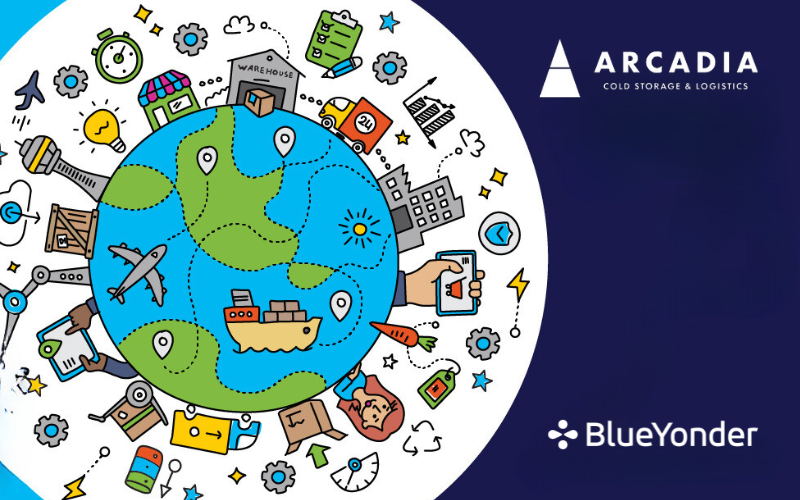In honor of National Logistics Day last month, I had a Blue Yonder Live conversation with Arcadia Cold’s JD Schwefler, Head of Site Selection & Design Solutions. JD shared his insights into how to have a long-term logistics career and how he and his company leverage technology to improve business outcomes. Here is Part 1 of the conversation.
Reward and Grit
Terence: Share with us the importance of logistics and supply chain to our day-to-day lives, as well as business outcomes?
JD: Logistics and supply chain certainly impact people’s everyday lives. Think cell phones to the food that people eat and everything in between. I’ve been in the food distribution business, and that’s the business that I would probably most relate to being able to talk to you about today. There is a lot of complexity in bringing food to your plate whether at home or a restaurant. We have to coordinate many processes, resources, and logistics systems in order to move the food through the supply chain.
One example is seafood: we could have seafood that is caught in the North Pacific that is brought to the U.S. for storage. Another type of seafood can be shipped in a container from the U.S. over to Asia for example, where they further process seafood into a consumer-packaged unit and then it is shipped back to the U.S. in a frozen container where it enters the grocery distribution or the food service logistics environment and ultimately to your plate.
The coordination of these activities at each stage of the process takes a lot of effort: it involves people, facilities, systems, regulatory agencies, and supplies, which ultimately is what logistics is. These logistics activities are carried out by professionals every day. There are truck drivers, warehouse, port, airline, and railroad workers. There are many potential supply chain disruptions that could breakdown the logistics environment, impacting workers and consumers. It is important to have good planning, data, and systems in place to manage the logistics environment.
Terence: What excites you about being part of this industry? Can you share some stories?
JD: Absolutely. I studied Industrial Engineering at Georgia Tech and learned about logistics systems. I initially worked in High Tech manufacturing for a microchip manufacturer and an electronics manufacturing group, where I cut my teeth on logistics. I learned the importance of the coordination and planning it takes to get products together to manufacture something as complex and has as many components in it as a cell phone does.
I moved into food distribution initially thinking that it was going to be simpler, but it is certainly not that. I learned that temperature-controlled food distribution has its own challenges and complexities. I then spent the last 20 years in the U.S., Asia, Europe, and South America, learning about different food logistics environments and developing solutions for both ourselves and our customers, based on different commodity type flows. I get up in the morning because I am able to help solve important logistical challenges!
But the logistics industry represents grit. No matter where you work within it, it is not easy. Your job is never fully done – you wake up every morning and you have a different challenge. The new wrinkle that can occur just because of all the different moving pieces. I love this industry and I encourage people to learn more about it. You have to be able to plan, you have to be tough, you have to have grit, and you have to get up when you’re knocked down, and you have to roll with the punches when you are faced with challenges.
Technology Plays a Key Role in Logistics
Terence: Let us drill down onto the technology side. Can you highlight how Arcadia Cold is using technology to realize business opportunities and overcome the many logistics challenges that you have been seeing in the past few years?
JD: The average age of cold storage warehouses in the U.S. is 40-plus years old. E-commerce and direct-to-consumer programs are demanding the industry to carve out space for doing more. This is part of the reason that we have to modernize our infrastructure. Our company has been building new cold storage warehouse in the U.S. We are at a point where having the right dock size and right facilities in the right location are extremely important.
We are leveraging Blue Yonder’s supply chain “operating system” and solutions, including Warehouse Management System (WMS), Transportation Management System (TMS), Warehouse Execution System (WES), and Labor Management. And Blue Yonder has been a tremendous partner, integrating with our enterprise systems and web portals so that our customers can have transparency and the information to succeed.
We are able to provide them with a view of what their business looks like, as we are an extension of their business. With our systems, they can see the products traveling along at different points.
For a food manufacturer that is working with a retailer or food service company, as extension of their business, we can give the statuses and accurate arrival time of products at our destinations and at our food manufacturer’s customer’s destination. If there are any issues with traffic, they can alert their customers. The value we provide is transparency in addition to other aspects such as accuracies. A key enabler is the Blue Yonder technology.
More Insights to Come
In an upcoming Part 2 article, we will get more insights from JD about his advice to those who are interested to pursue logistics careers and additional benefits of technologies.
Learn More
For more insights about logistics and supply chain challenges and investments in solutions, please review the recently published 2023 Supply Chain Executive Survey e-book. Learn about First-to-Last-Mile Optimization solutions here. Watch the Blue Yonder Live conversation here.

